Analysis of Teamwork and Organizational Management in Global Context
VerifiedAdded on 2020/05/28
|15
|4379
|58
Report
AI Summary
This report provides an in-depth analysis of teamwork and organizational management within a global environment. It begins with an executive summary highlighting the importance of teamwork in modern business, emphasizing its benefits for both organizations and individuals. The introduction establishes the significance of teamwork in enhancing work quality, reducing errors, and fostering individual support. The report then delves into Tuckman's team development model, outlining the stages of forming, storming, norming, performing, and adjourning, and the role of leaders at each stage. It compares managerial decision-making with team decision-making, highlighting the advantages of collaborative approaches. The report also discusses physical structures designed to facilitate teamwork, such as communication channels. Finally, it explores ways in which managers can promote teamwork, concluding with a summary of key findings and references.
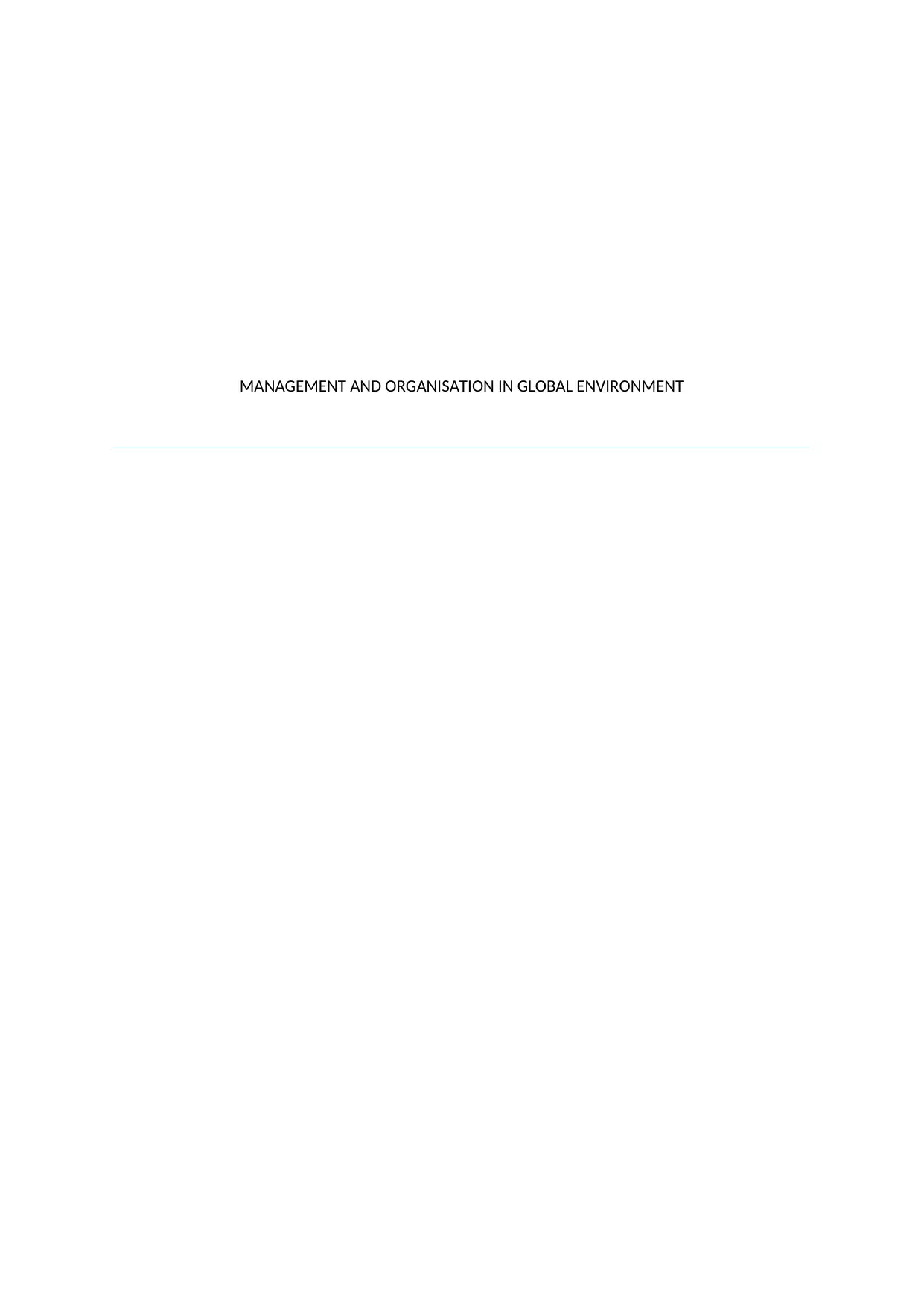
MANAGEMENT AND ORGANISATION IN GLOBAL ENVIRONMENT
Paraphrase This Document
Need a fresh take? Get an instant paraphrase of this document with our AI Paraphraser
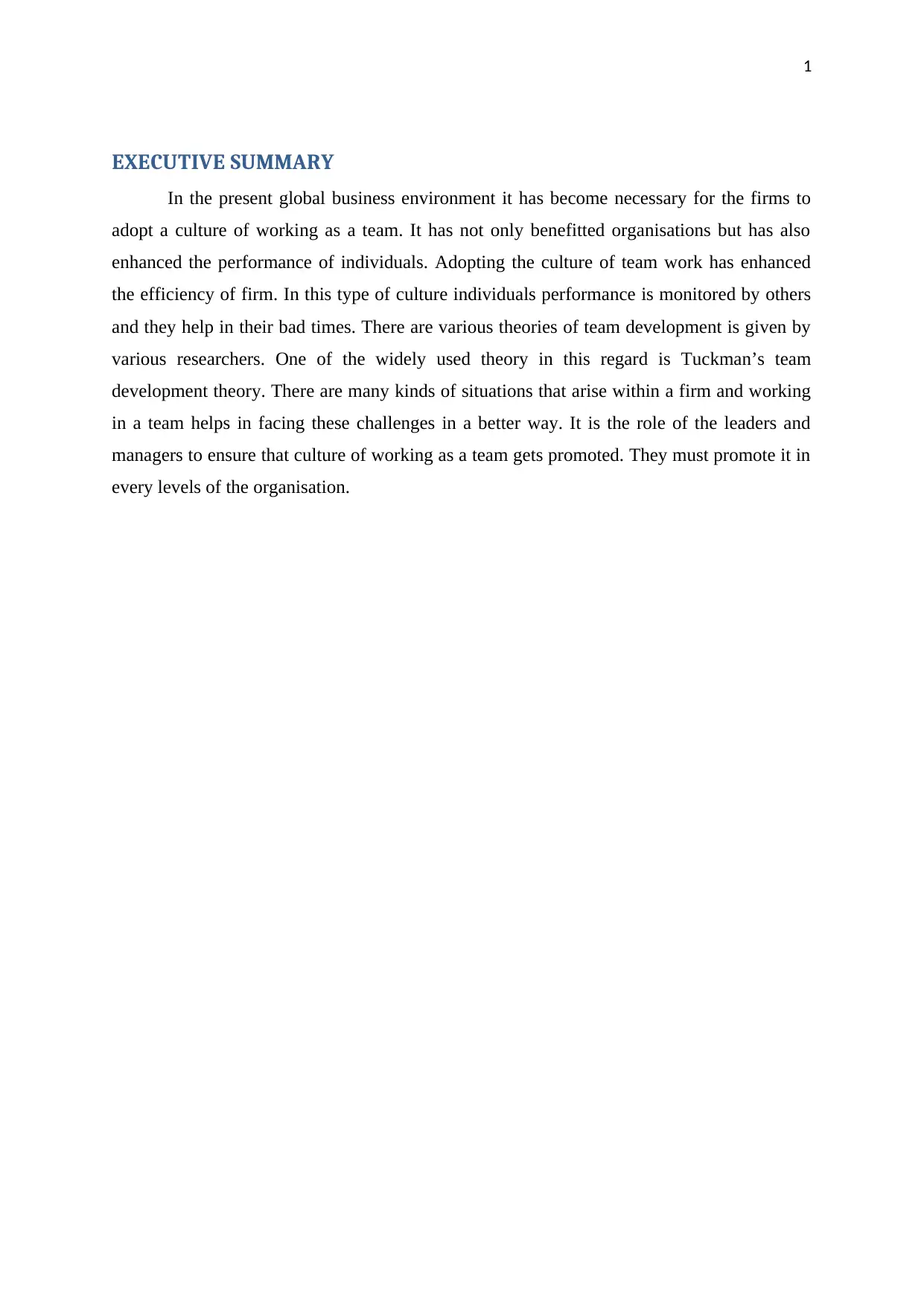
1
EXECUTIVE SUMMARY
In the present global business environment it has become necessary for the firms to
adopt a culture of working as a team. It has not only benefitted organisations but has also
enhanced the performance of individuals. Adopting the culture of team work has enhanced
the efficiency of firm. In this type of culture individuals performance is monitored by others
and they help in their bad times. There are various theories of team development is given by
various researchers. One of the widely used theory in this regard is Tuckman’s team
development theory. There are many kinds of situations that arise within a firm and working
in a team helps in facing these challenges in a better way. It is the role of the leaders and
managers to ensure that culture of working as a team gets promoted. They must promote it in
every levels of the organisation.
EXECUTIVE SUMMARY
In the present global business environment it has become necessary for the firms to
adopt a culture of working as a team. It has not only benefitted organisations but has also
enhanced the performance of individuals. Adopting the culture of team work has enhanced
the efficiency of firm. In this type of culture individuals performance is monitored by others
and they help in their bad times. There are various theories of team development is given by
various researchers. One of the widely used theory in this regard is Tuckman’s team
development theory. There are many kinds of situations that arise within a firm and working
in a team helps in facing these challenges in a better way. It is the role of the leaders and
managers to ensure that culture of working as a team gets promoted. They must promote it in
every levels of the organisation.
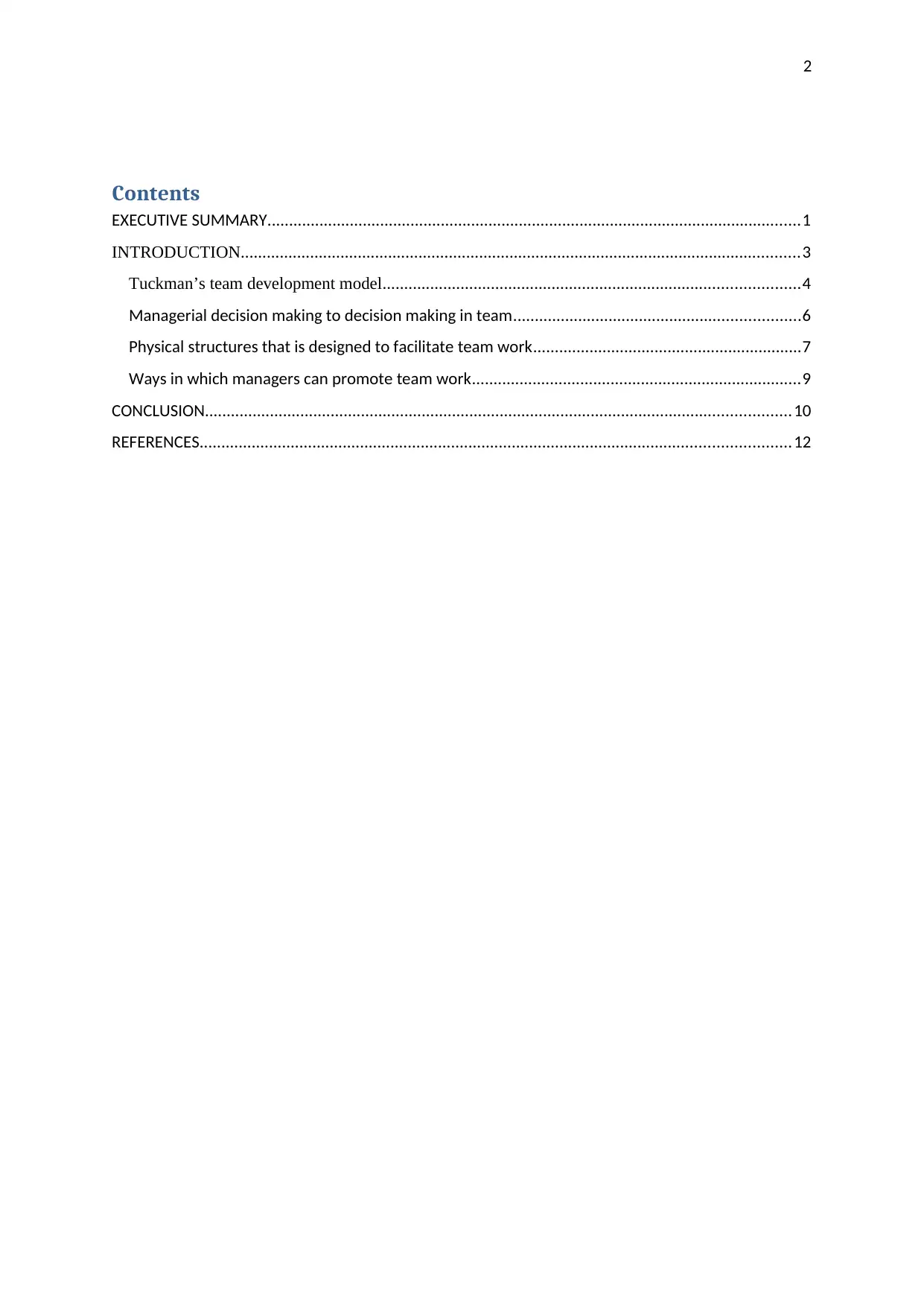
2
Contents
EXECUTIVE SUMMARY...........................................................................................................................1
INTRODUCTION.................................................................................................................................3
Tuckman’s team development model................................................................................................4
Managerial decision making to decision making in team..................................................................6
Physical structures that is designed to facilitate team work..............................................................7
Ways in which managers can promote team work............................................................................9
CONCLUSION.......................................................................................................................................10
REFERENCES........................................................................................................................................12
Contents
EXECUTIVE SUMMARY...........................................................................................................................1
INTRODUCTION.................................................................................................................................3
Tuckman’s team development model................................................................................................4
Managerial decision making to decision making in team..................................................................6
Physical structures that is designed to facilitate team work..............................................................7
Ways in which managers can promote team work............................................................................9
CONCLUSION.......................................................................................................................................10
REFERENCES........................................................................................................................................12
⊘ This is a preview!⊘
Do you want full access?
Subscribe today to unlock all pages.

Trusted by 1+ million students worldwide
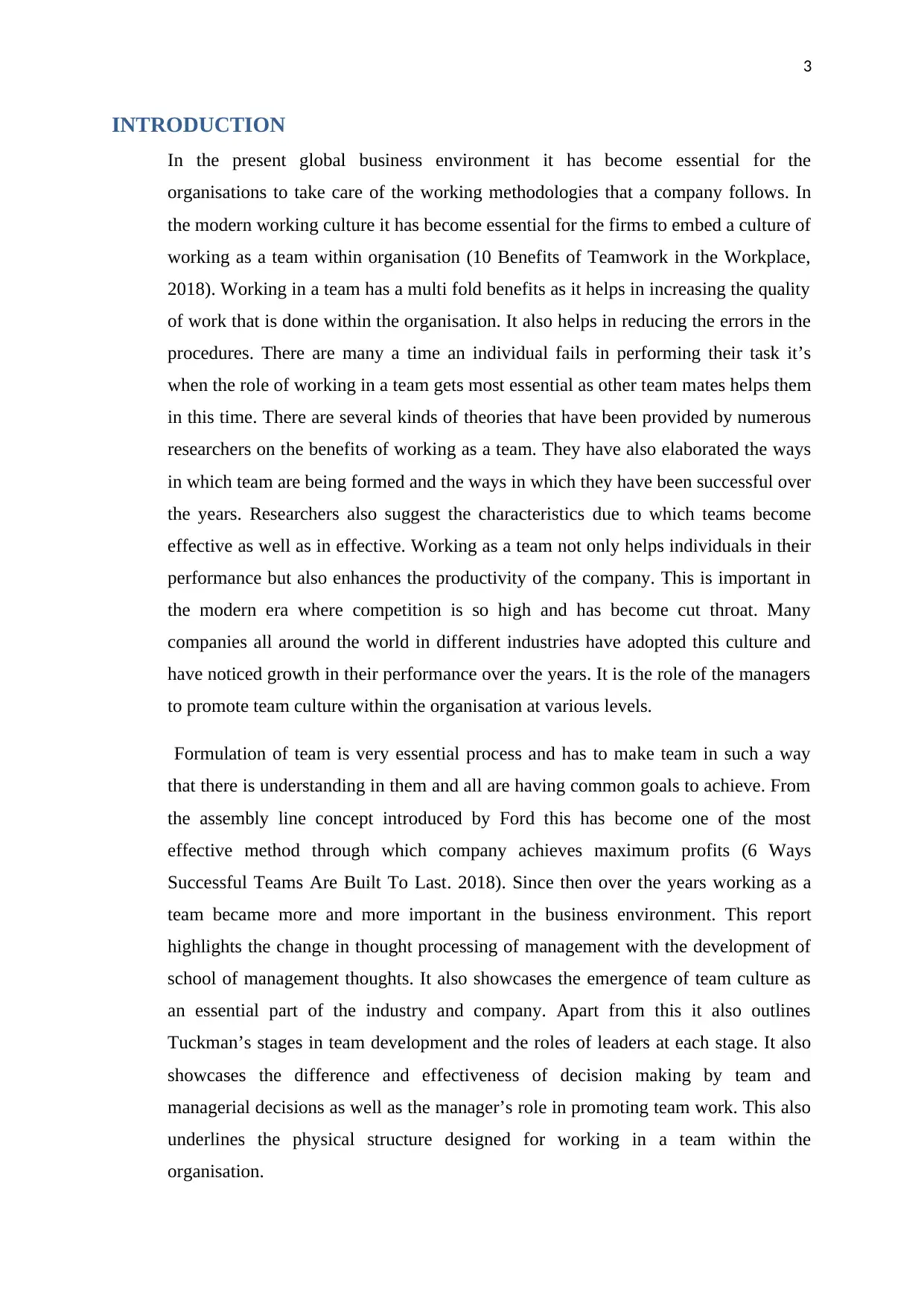
3
INTRODUCTION
In the present global business environment it has become essential for the
organisations to take care of the working methodologies that a company follows. In
the modern working culture it has become essential for the firms to embed a culture of
working as a team within organisation (10 Benefits of Teamwork in the Workplace,
2018). Working in a team has a multi fold benefits as it helps in increasing the quality
of work that is done within the organisation. It also helps in reducing the errors in the
procedures. There are many a time an individual fails in performing their task it’s
when the role of working in a team gets most essential as other team mates helps them
in this time. There are several kinds of theories that have been provided by numerous
researchers on the benefits of working as a team. They have also elaborated the ways
in which team are being formed and the ways in which they have been successful over
the years. Researchers also suggest the characteristics due to which teams become
effective as well as in effective. Working as a team not only helps individuals in their
performance but also enhances the productivity of the company. This is important in
the modern era where competition is so high and has become cut throat. Many
companies all around the world in different industries have adopted this culture and
have noticed growth in their performance over the years. It is the role of the managers
to promote team culture within the organisation at various levels.
Formulation of team is very essential process and has to make team in such a way
that there is understanding in them and all are having common goals to achieve. From
the assembly line concept introduced by Ford this has become one of the most
effective method through which company achieves maximum profits (6 Ways
Successful Teams Are Built To Last. 2018). Since then over the years working as a
team became more and more important in the business environment. This report
highlights the change in thought processing of management with the development of
school of management thoughts. It also showcases the emergence of team culture as
an essential part of the industry and company. Apart from this it also outlines
Tuckman’s stages in team development and the roles of leaders at each stage. It also
showcases the difference and effectiveness of decision making by team and
managerial decisions as well as the manager’s role in promoting team work. This also
underlines the physical structure designed for working in a team within the
organisation.
INTRODUCTION
In the present global business environment it has become essential for the
organisations to take care of the working methodologies that a company follows. In
the modern working culture it has become essential for the firms to embed a culture of
working as a team within organisation (10 Benefits of Teamwork in the Workplace,
2018). Working in a team has a multi fold benefits as it helps in increasing the quality
of work that is done within the organisation. It also helps in reducing the errors in the
procedures. There are many a time an individual fails in performing their task it’s
when the role of working in a team gets most essential as other team mates helps them
in this time. There are several kinds of theories that have been provided by numerous
researchers on the benefits of working as a team. They have also elaborated the ways
in which team are being formed and the ways in which they have been successful over
the years. Researchers also suggest the characteristics due to which teams become
effective as well as in effective. Working as a team not only helps individuals in their
performance but also enhances the productivity of the company. This is important in
the modern era where competition is so high and has become cut throat. Many
companies all around the world in different industries have adopted this culture and
have noticed growth in their performance over the years. It is the role of the managers
to promote team culture within the organisation at various levels.
Formulation of team is very essential process and has to make team in such a way
that there is understanding in them and all are having common goals to achieve. From
the assembly line concept introduced by Ford this has become one of the most
effective method through which company achieves maximum profits (6 Ways
Successful Teams Are Built To Last. 2018). Since then over the years working as a
team became more and more important in the business environment. This report
highlights the change in thought processing of management with the development of
school of management thoughts. It also showcases the emergence of team culture as
an essential part of the industry and company. Apart from this it also outlines
Tuckman’s stages in team development and the roles of leaders at each stage. It also
showcases the difference and effectiveness of decision making by team and
managerial decisions as well as the manager’s role in promoting team work. This also
underlines the physical structure designed for working in a team within the
organisation.
Paraphrase This Document
Need a fresh take? Get an instant paraphrase of this document with our AI Paraphraser
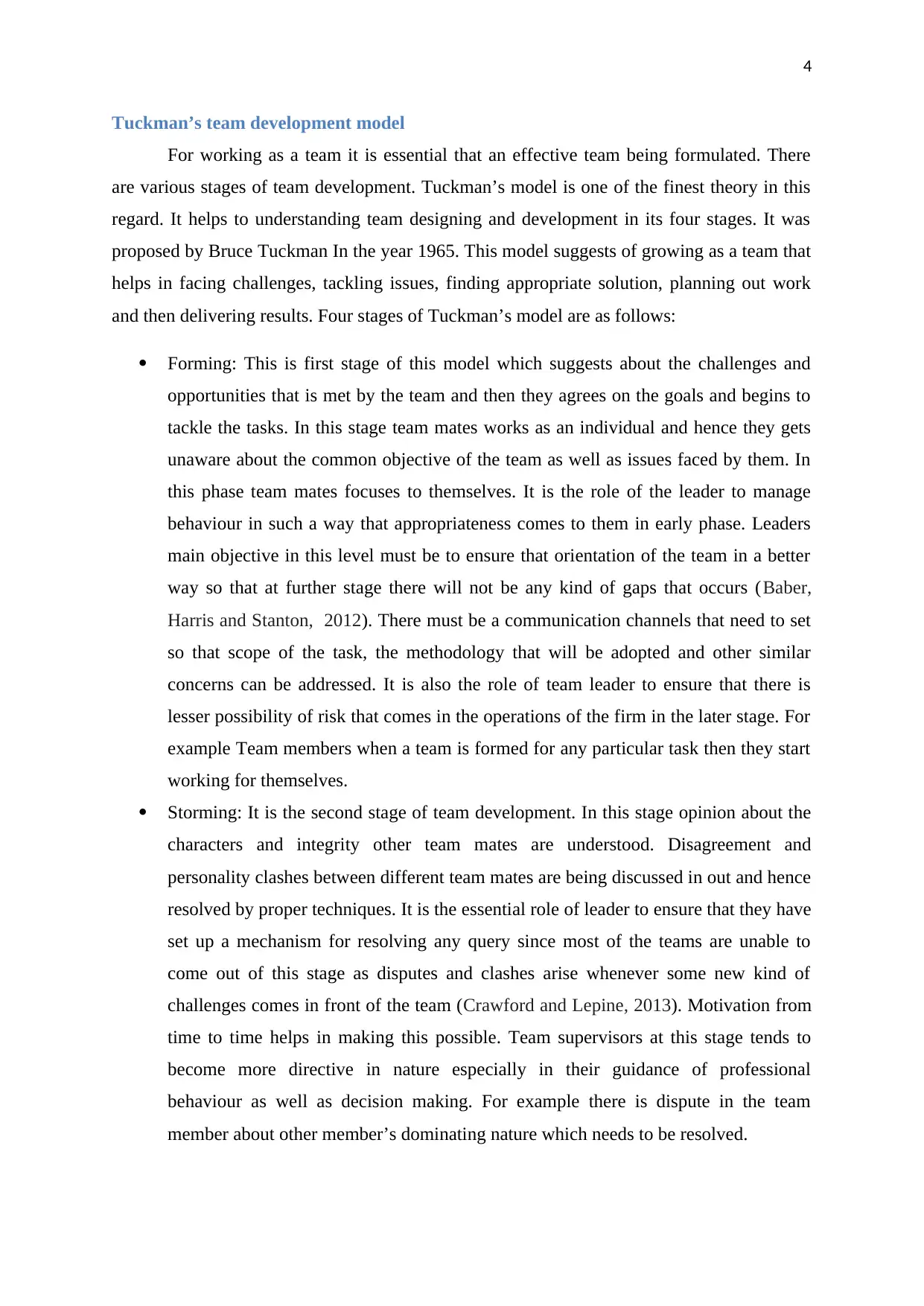
4
Tuckman’s team development model
For working as a team it is essential that an effective team being formulated. There
are various stages of team development. Tuckman’s model is one of the finest theory in this
regard. It helps to understanding team designing and development in its four stages. It was
proposed by Bruce Tuckman In the year 1965. This model suggests of growing as a team that
helps in facing challenges, tackling issues, finding appropriate solution, planning out work
and then delivering results. Four stages of Tuckman’s model are as follows:
Forming: This is first stage of this model which suggests about the challenges and
opportunities that is met by the team and then they agrees on the goals and begins to
tackle the tasks. In this stage team mates works as an individual and hence they gets
unaware about the common objective of the team as well as issues faced by them. In
this phase team mates focuses to themselves. It is the role of the leader to manage
behaviour in such a way that appropriateness comes to them in early phase. Leaders
main objective in this level must be to ensure that orientation of the team in a better
way so that at further stage there will not be any kind of gaps that occurs (Baber,
Harris and Stanton, 2012). There must be a communication channels that need to set
so that scope of the task, the methodology that will be adopted and other similar
concerns can be addressed. It is also the role of team leader to ensure that there is
lesser possibility of risk that comes in the operations of the firm in the later stage. For
example Team members when a team is formed for any particular task then they start
working for themselves.
Storming: It is the second stage of team development. In this stage opinion about the
characters and integrity other team mates are understood. Disagreement and
personality clashes between different team mates are being discussed in out and hence
resolved by proper techniques. It is the essential role of leader to ensure that they have
set up a mechanism for resolving any query since most of the teams are unable to
come out of this stage as disputes and clashes arise whenever some new kind of
challenges comes in front of the team (Crawford and Lepine, 2013). Motivation from
time to time helps in making this possible. Team supervisors at this stage tends to
become more directive in nature especially in their guidance of professional
behaviour as well as decision making. For example there is dispute in the team
member about other member’s dominating nature which needs to be resolved.
Tuckman’s team development model
For working as a team it is essential that an effective team being formulated. There
are various stages of team development. Tuckman’s model is one of the finest theory in this
regard. It helps to understanding team designing and development in its four stages. It was
proposed by Bruce Tuckman In the year 1965. This model suggests of growing as a team that
helps in facing challenges, tackling issues, finding appropriate solution, planning out work
and then delivering results. Four stages of Tuckman’s model are as follows:
Forming: This is first stage of this model which suggests about the challenges and
opportunities that is met by the team and then they agrees on the goals and begins to
tackle the tasks. In this stage team mates works as an individual and hence they gets
unaware about the common objective of the team as well as issues faced by them. In
this phase team mates focuses to themselves. It is the role of the leader to manage
behaviour in such a way that appropriateness comes to them in early phase. Leaders
main objective in this level must be to ensure that orientation of the team in a better
way so that at further stage there will not be any kind of gaps that occurs (Baber,
Harris and Stanton, 2012). There must be a communication channels that need to set
so that scope of the task, the methodology that will be adopted and other similar
concerns can be addressed. It is also the role of team leader to ensure that there is
lesser possibility of risk that comes in the operations of the firm in the later stage. For
example Team members when a team is formed for any particular task then they start
working for themselves.
Storming: It is the second stage of team development. In this stage opinion about the
characters and integrity other team mates are understood. Disagreement and
personality clashes between different team mates are being discussed in out and hence
resolved by proper techniques. It is the essential role of leader to ensure that they have
set up a mechanism for resolving any query since most of the teams are unable to
come out of this stage as disputes and clashes arise whenever some new kind of
challenges comes in front of the team (Crawford and Lepine, 2013). Motivation from
time to time helps in making this possible. Team supervisors at this stage tends to
become more directive in nature especially in their guidance of professional
behaviour as well as decision making. For example there is dispute in the team
member about other member’s dominating nature which needs to be resolved.
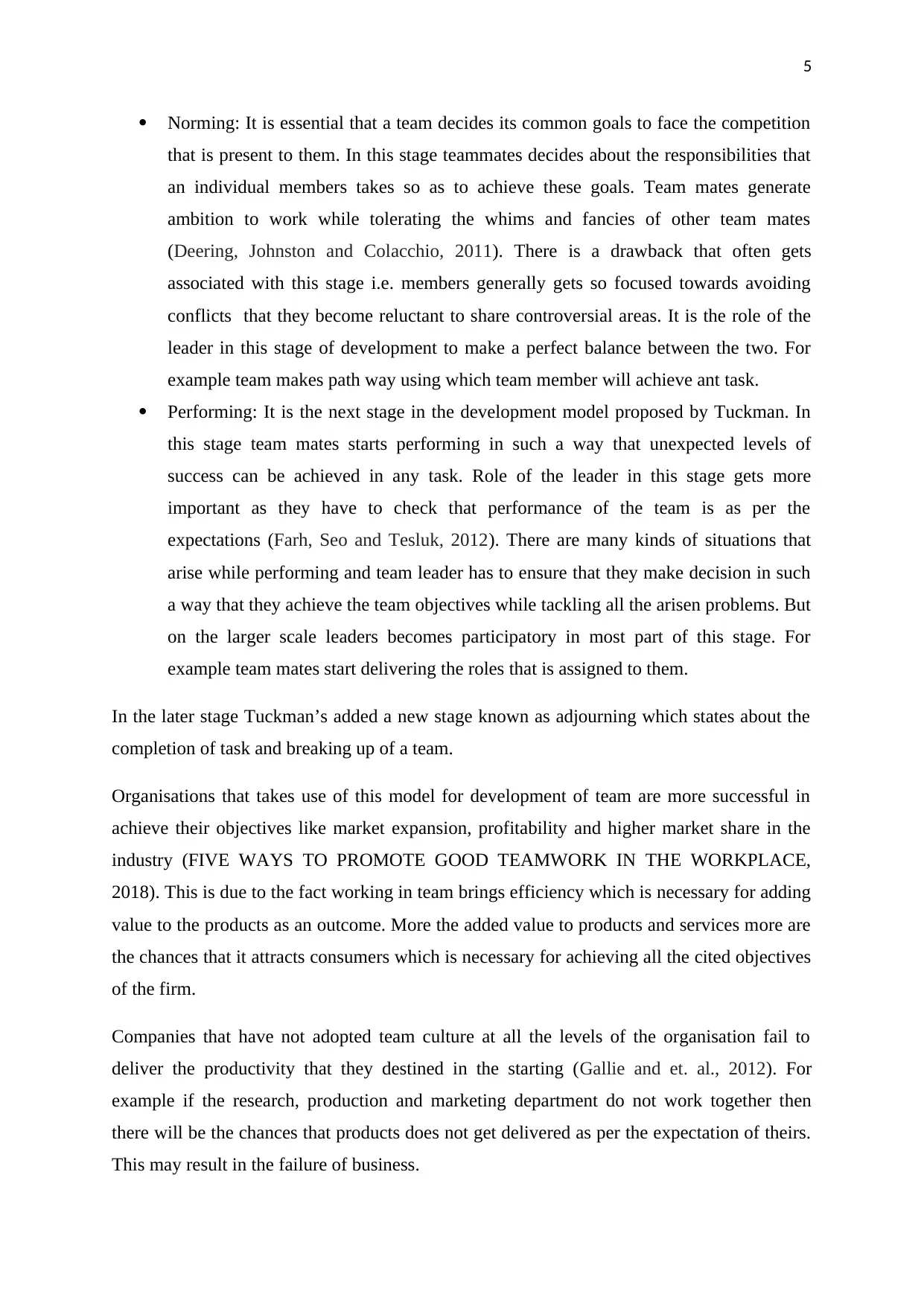
5
Norming: It is essential that a team decides its common goals to face the competition
that is present to them. In this stage teammates decides about the responsibilities that
an individual members takes so as to achieve these goals. Team mates generate
ambition to work while tolerating the whims and fancies of other team mates
(Deering, Johnston and Colacchio, 2011). There is a drawback that often gets
associated with this stage i.e. members generally gets so focused towards avoiding
conflicts that they become reluctant to share controversial areas. It is the role of the
leader in this stage of development to make a perfect balance between the two. For
example team makes path way using which team member will achieve ant task.
Performing: It is the next stage in the development model proposed by Tuckman. In
this stage team mates starts performing in such a way that unexpected levels of
success can be achieved in any task. Role of the leader in this stage gets more
important as they have to check that performance of the team is as per the
expectations (Farh, Seo and Tesluk, 2012). There are many kinds of situations that
arise while performing and team leader has to ensure that they make decision in such
a way that they achieve the team objectives while tackling all the arisen problems. But
on the larger scale leaders becomes participatory in most part of this stage. For
example team mates start delivering the roles that is assigned to them.
In the later stage Tuckman’s added a new stage known as adjourning which states about the
completion of task and breaking up of a team.
Organisations that takes use of this model for development of team are more successful in
achieve their objectives like market expansion, profitability and higher market share in the
industry (FIVE WAYS TO PROMOTE GOOD TEAMWORK IN THE WORKPLACE,
2018). This is due to the fact working in team brings efficiency which is necessary for adding
value to the products as an outcome. More the added value to products and services more are
the chances that it attracts consumers which is necessary for achieving all the cited objectives
of the firm.
Companies that have not adopted team culture at all the levels of the organisation fail to
deliver the productivity that they destined in the starting (Gallie and et. al., 2012). For
example if the research, production and marketing department do not work together then
there will be the chances that products does not get delivered as per the expectation of theirs.
This may result in the failure of business.
Norming: It is essential that a team decides its common goals to face the competition
that is present to them. In this stage teammates decides about the responsibilities that
an individual members takes so as to achieve these goals. Team mates generate
ambition to work while tolerating the whims and fancies of other team mates
(Deering, Johnston and Colacchio, 2011). There is a drawback that often gets
associated with this stage i.e. members generally gets so focused towards avoiding
conflicts that they become reluctant to share controversial areas. It is the role of the
leader in this stage of development to make a perfect balance between the two. For
example team makes path way using which team member will achieve ant task.
Performing: It is the next stage in the development model proposed by Tuckman. In
this stage team mates starts performing in such a way that unexpected levels of
success can be achieved in any task. Role of the leader in this stage gets more
important as they have to check that performance of the team is as per the
expectations (Farh, Seo and Tesluk, 2012). There are many kinds of situations that
arise while performing and team leader has to ensure that they make decision in such
a way that they achieve the team objectives while tackling all the arisen problems. But
on the larger scale leaders becomes participatory in most part of this stage. For
example team mates start delivering the roles that is assigned to them.
In the later stage Tuckman’s added a new stage known as adjourning which states about the
completion of task and breaking up of a team.
Organisations that takes use of this model for development of team are more successful in
achieve their objectives like market expansion, profitability and higher market share in the
industry (FIVE WAYS TO PROMOTE GOOD TEAMWORK IN THE WORKPLACE,
2018). This is due to the fact working in team brings efficiency which is necessary for adding
value to the products as an outcome. More the added value to products and services more are
the chances that it attracts consumers which is necessary for achieving all the cited objectives
of the firm.
Companies that have not adopted team culture at all the levels of the organisation fail to
deliver the productivity that they destined in the starting (Gallie and et. al., 2012). For
example if the research, production and marketing department do not work together then
there will be the chances that products does not get delivered as per the expectation of theirs.
This may result in the failure of business.
⊘ This is a preview!⊘
Do you want full access?
Subscribe today to unlock all pages.

Trusted by 1+ million students worldwide
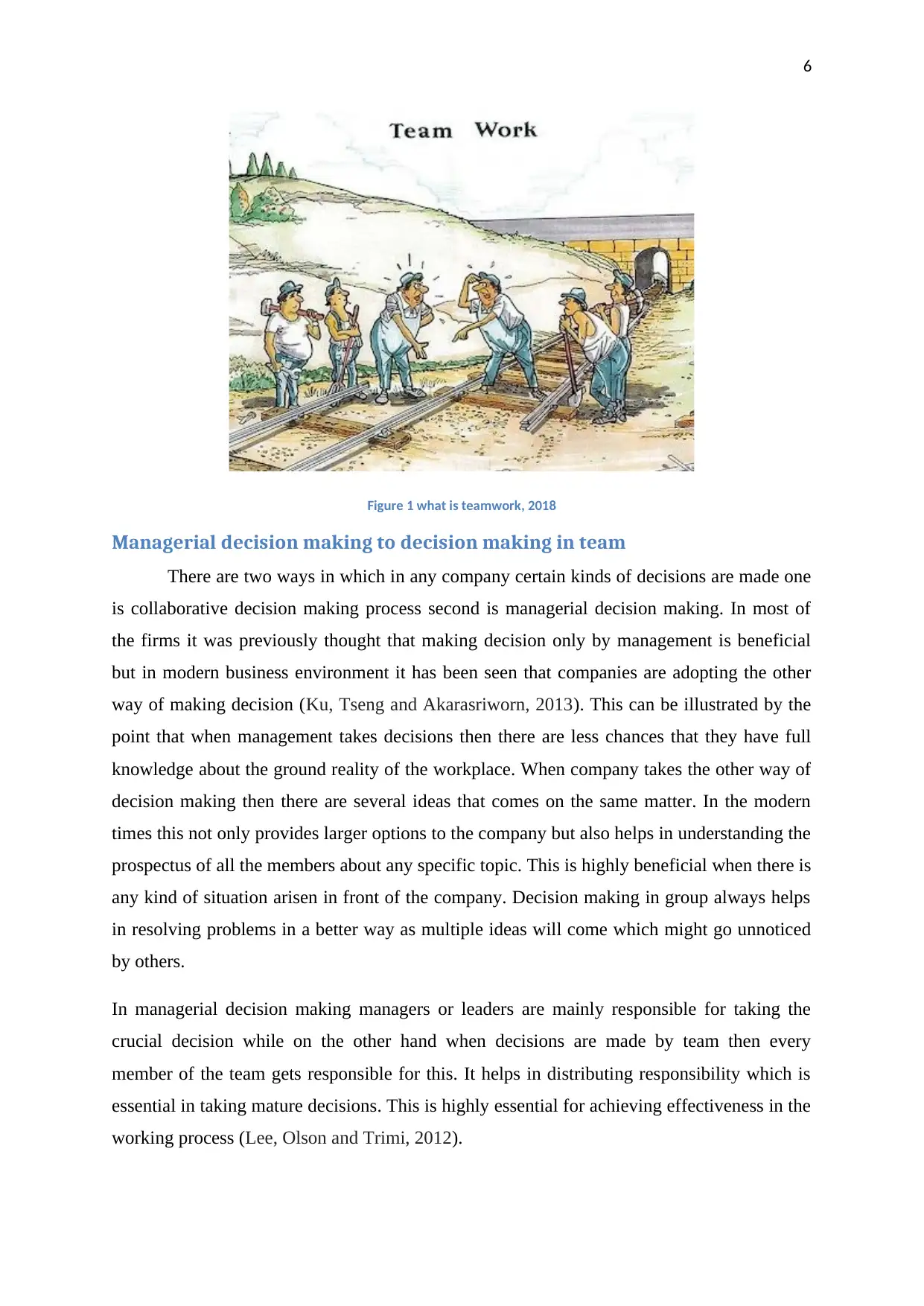
6
Figure 1 what is teamwork, 2018
Managerial decision making to decision making in team
There are two ways in which in any company certain kinds of decisions are made one
is collaborative decision making process second is managerial decision making. In most of
the firms it was previously thought that making decision only by management is beneficial
but in modern business environment it has been seen that companies are adopting the other
way of making decision (Ku, Tseng and Akarasriworn, 2013). This can be illustrated by the
point that when management takes decisions then there are less chances that they have full
knowledge about the ground reality of the workplace. When company takes the other way of
decision making then there are several ideas that comes on the same matter. In the modern
times this not only provides larger options to the company but also helps in understanding the
prospectus of all the members about any specific topic. This is highly beneficial when there is
any kind of situation arisen in front of the company. Decision making in group always helps
in resolving problems in a better way as multiple ideas will come which might go unnoticed
by others.
In managerial decision making managers or leaders are mainly responsible for taking the
crucial decision while on the other hand when decisions are made by team then every
member of the team gets responsible for this. It helps in distributing responsibility which is
essential in taking mature decisions. This is highly essential for achieving effectiveness in the
working process (Lee, Olson and Trimi, 2012).
Figure 1 what is teamwork, 2018
Managerial decision making to decision making in team
There are two ways in which in any company certain kinds of decisions are made one
is collaborative decision making process second is managerial decision making. In most of
the firms it was previously thought that making decision only by management is beneficial
but in modern business environment it has been seen that companies are adopting the other
way of making decision (Ku, Tseng and Akarasriworn, 2013). This can be illustrated by the
point that when management takes decisions then there are less chances that they have full
knowledge about the ground reality of the workplace. When company takes the other way of
decision making then there are several ideas that comes on the same matter. In the modern
times this not only provides larger options to the company but also helps in understanding the
prospectus of all the members about any specific topic. This is highly beneficial when there is
any kind of situation arisen in front of the company. Decision making in group always helps
in resolving problems in a better way as multiple ideas will come which might go unnoticed
by others.
In managerial decision making managers or leaders are mainly responsible for taking the
crucial decision while on the other hand when decisions are made by team then every
member of the team gets responsible for this. It helps in distributing responsibility which is
essential in taking mature decisions. This is highly essential for achieving effectiveness in the
working process (Lee, Olson and Trimi, 2012).
Paraphrase This Document
Need a fresh take? Get an instant paraphrase of this document with our AI Paraphraser
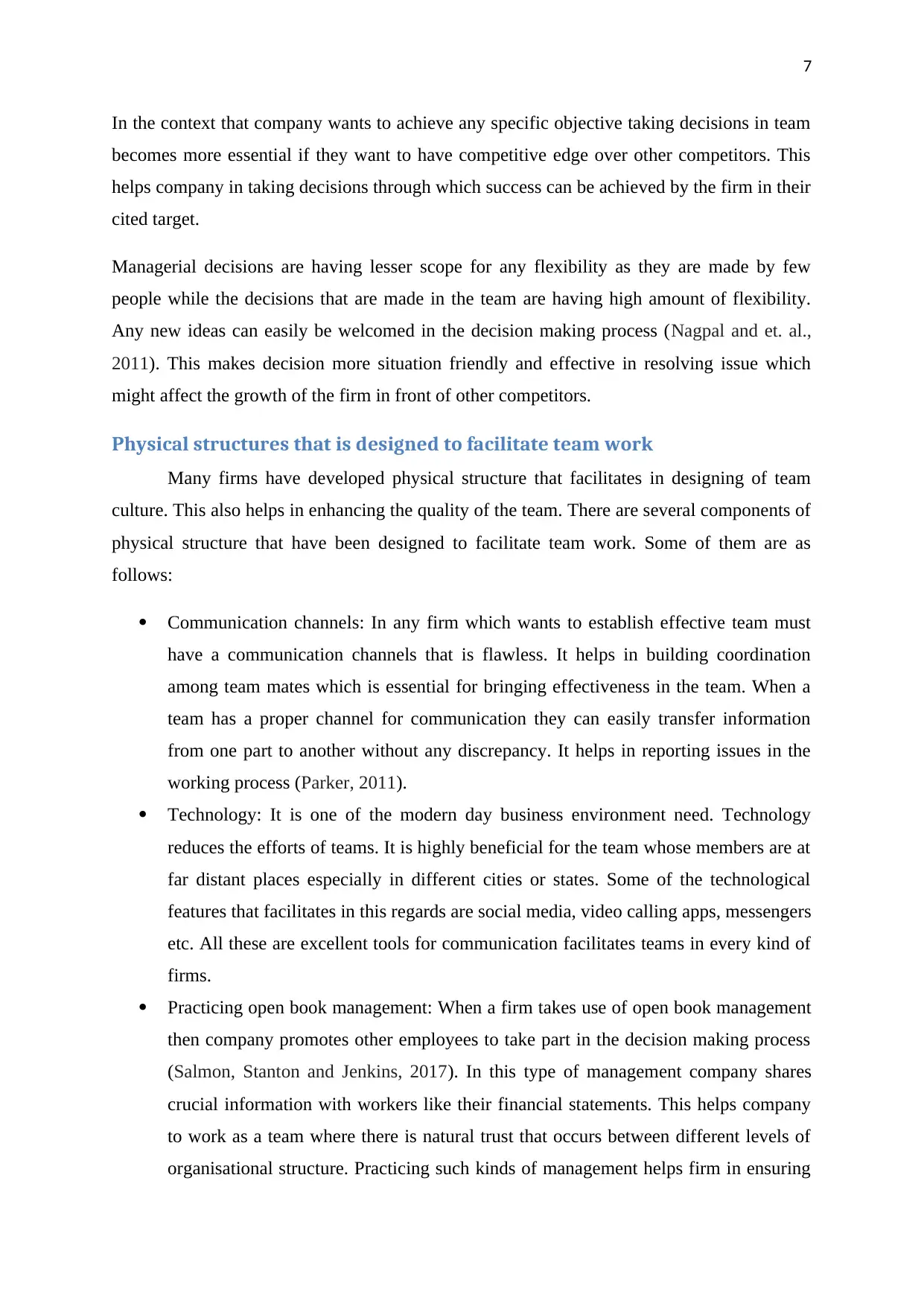
7
In the context that company wants to achieve any specific objective taking decisions in team
becomes more essential if they want to have competitive edge over other competitors. This
helps company in taking decisions through which success can be achieved by the firm in their
cited target.
Managerial decisions are having lesser scope for any flexibility as they are made by few
people while the decisions that are made in the team are having high amount of flexibility.
Any new ideas can easily be welcomed in the decision making process (Nagpal and et. al.,
2011). This makes decision more situation friendly and effective in resolving issue which
might affect the growth of the firm in front of other competitors.
Physical structures that is designed to facilitate team work
Many firms have developed physical structure that facilitates in designing of team
culture. This also helps in enhancing the quality of the team. There are several components of
physical structure that have been designed to facilitate team work. Some of them are as
follows:
Communication channels: In any firm which wants to establish effective team must
have a communication channels that is flawless. It helps in building coordination
among team mates which is essential for bringing effectiveness in the team. When a
team has a proper channel for communication they can easily transfer information
from one part to another without any discrepancy. It helps in reporting issues in the
working process (Parker, 2011).
Technology: It is one of the modern day business environment need. Technology
reduces the efforts of teams. It is highly beneficial for the team whose members are at
far distant places especially in different cities or states. Some of the technological
features that facilitates in this regards are social media, video calling apps, messengers
etc. All these are excellent tools for communication facilitates teams in every kind of
firms.
Practicing open book management: When a firm takes use of open book management
then company promotes other employees to take part in the decision making process
(Salmon, Stanton and Jenkins, 2017). In this type of management company shares
crucial information with workers like their financial statements. This helps company
to work as a team where there is natural trust that occurs between different levels of
organisational structure. Practicing such kinds of management helps firm in ensuring
In the context that company wants to achieve any specific objective taking decisions in team
becomes more essential if they want to have competitive edge over other competitors. This
helps company in taking decisions through which success can be achieved by the firm in their
cited target.
Managerial decisions are having lesser scope for any flexibility as they are made by few
people while the decisions that are made in the team are having high amount of flexibility.
Any new ideas can easily be welcomed in the decision making process (Nagpal and et. al.,
2011). This makes decision more situation friendly and effective in resolving issue which
might affect the growth of the firm in front of other competitors.
Physical structures that is designed to facilitate team work
Many firms have developed physical structure that facilitates in designing of team
culture. This also helps in enhancing the quality of the team. There are several components of
physical structure that have been designed to facilitate team work. Some of them are as
follows:
Communication channels: In any firm which wants to establish effective team must
have a communication channels that is flawless. It helps in building coordination
among team mates which is essential for bringing effectiveness in the team. When a
team has a proper channel for communication they can easily transfer information
from one part to another without any discrepancy. It helps in reporting issues in the
working process (Parker, 2011).
Technology: It is one of the modern day business environment need. Technology
reduces the efforts of teams. It is highly beneficial for the team whose members are at
far distant places especially in different cities or states. Some of the technological
features that facilitates in this regards are social media, video calling apps, messengers
etc. All these are excellent tools for communication facilitates teams in every kind of
firms.
Practicing open book management: When a firm takes use of open book management
then company promotes other employees to take part in the decision making process
(Salmon, Stanton and Jenkins, 2017). In this type of management company shares
crucial information with workers like their financial statements. This helps company
to work as a team where there is natural trust that occurs between different levels of
organisational structure. Practicing such kinds of management helps firm in ensuring
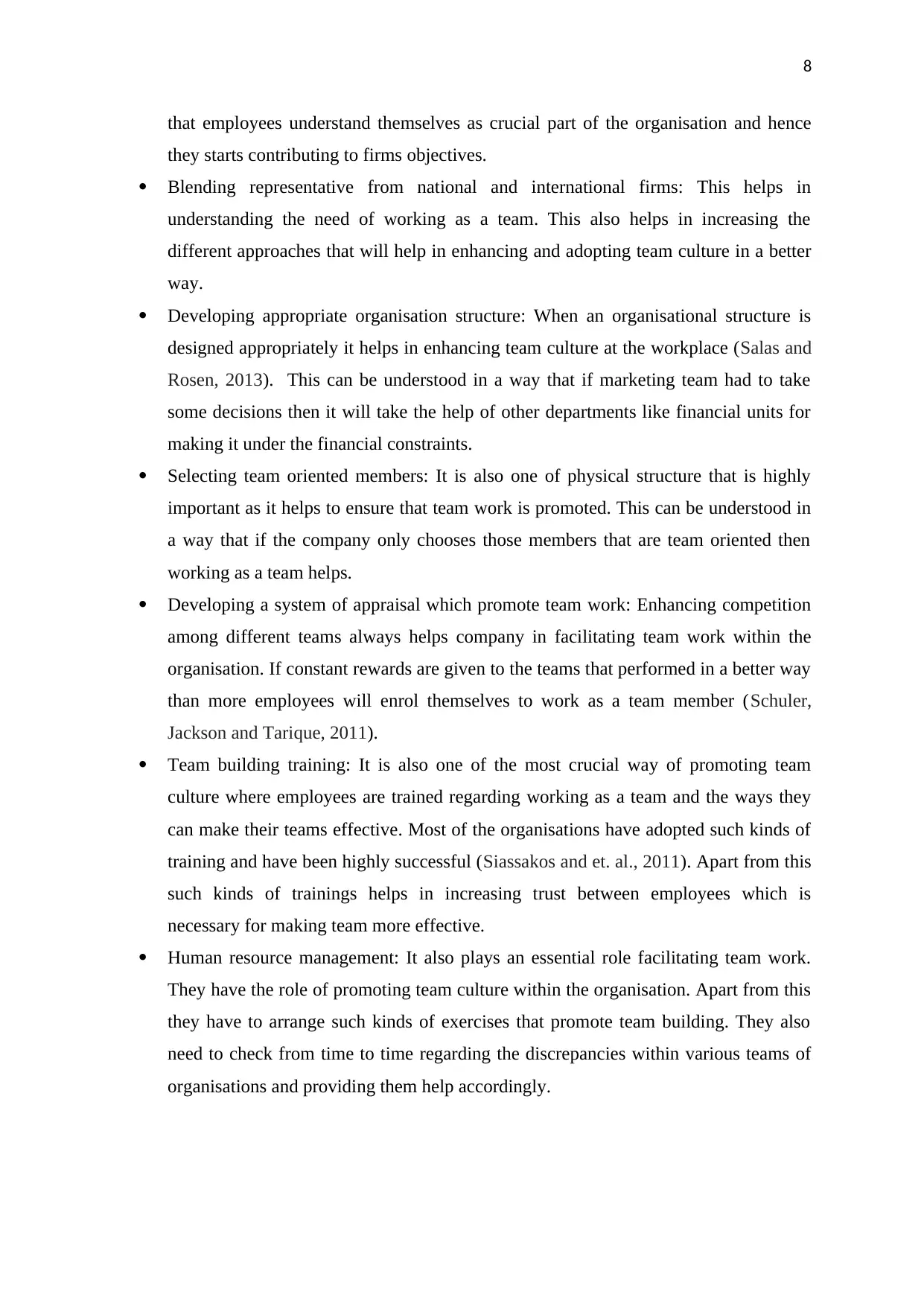
8
that employees understand themselves as crucial part of the organisation and hence
they starts contributing to firms objectives.
Blending representative from national and international firms: This helps in
understanding the need of working as a team. This also helps in increasing the
different approaches that will help in enhancing and adopting team culture in a better
way.
Developing appropriate organisation structure: When an organisational structure is
designed appropriately it helps in enhancing team culture at the workplace (Salas and
Rosen, 2013). This can be understood in a way that if marketing team had to take
some decisions then it will take the help of other departments like financial units for
making it under the financial constraints.
Selecting team oriented members: It is also one of physical structure that is highly
important as it helps to ensure that team work is promoted. This can be understood in
a way that if the company only chooses those members that are team oriented then
working as a team helps.
Developing a system of appraisal which promote team work: Enhancing competition
among different teams always helps company in facilitating team work within the
organisation. If constant rewards are given to the teams that performed in a better way
than more employees will enrol themselves to work as a team member (Schuler,
Jackson and Tarique, 2011).
Team building training: It is also one of the most crucial way of promoting team
culture where employees are trained regarding working as a team and the ways they
can make their teams effective. Most of the organisations have adopted such kinds of
training and have been highly successful (Siassakos and et. al., 2011). Apart from this
such kinds of trainings helps in increasing trust between employees which is
necessary for making team more effective.
Human resource management: It also plays an essential role facilitating team work.
They have the role of promoting team culture within the organisation. Apart from this
they have to arrange such kinds of exercises that promote team building. They also
need to check from time to time regarding the discrepancies within various teams of
organisations and providing them help accordingly.
that employees understand themselves as crucial part of the organisation and hence
they starts contributing to firms objectives.
Blending representative from national and international firms: This helps in
understanding the need of working as a team. This also helps in increasing the
different approaches that will help in enhancing and adopting team culture in a better
way.
Developing appropriate organisation structure: When an organisational structure is
designed appropriately it helps in enhancing team culture at the workplace (Salas and
Rosen, 2013). This can be understood in a way that if marketing team had to take
some decisions then it will take the help of other departments like financial units for
making it under the financial constraints.
Selecting team oriented members: It is also one of physical structure that is highly
important as it helps to ensure that team work is promoted. This can be understood in
a way that if the company only chooses those members that are team oriented then
working as a team helps.
Developing a system of appraisal which promote team work: Enhancing competition
among different teams always helps company in facilitating team work within the
organisation. If constant rewards are given to the teams that performed in a better way
than more employees will enrol themselves to work as a team member (Schuler,
Jackson and Tarique, 2011).
Team building training: It is also one of the most crucial way of promoting team
culture where employees are trained regarding working as a team and the ways they
can make their teams effective. Most of the organisations have adopted such kinds of
training and have been highly successful (Siassakos and et. al., 2011). Apart from this
such kinds of trainings helps in increasing trust between employees which is
necessary for making team more effective.
Human resource management: It also plays an essential role facilitating team work.
They have the role of promoting team culture within the organisation. Apart from this
they have to arrange such kinds of exercises that promote team building. They also
need to check from time to time regarding the discrepancies within various teams of
organisations and providing them help accordingly.
⊘ This is a preview!⊘
Do you want full access?
Subscribe today to unlock all pages.

Trusted by 1+ million students worldwide
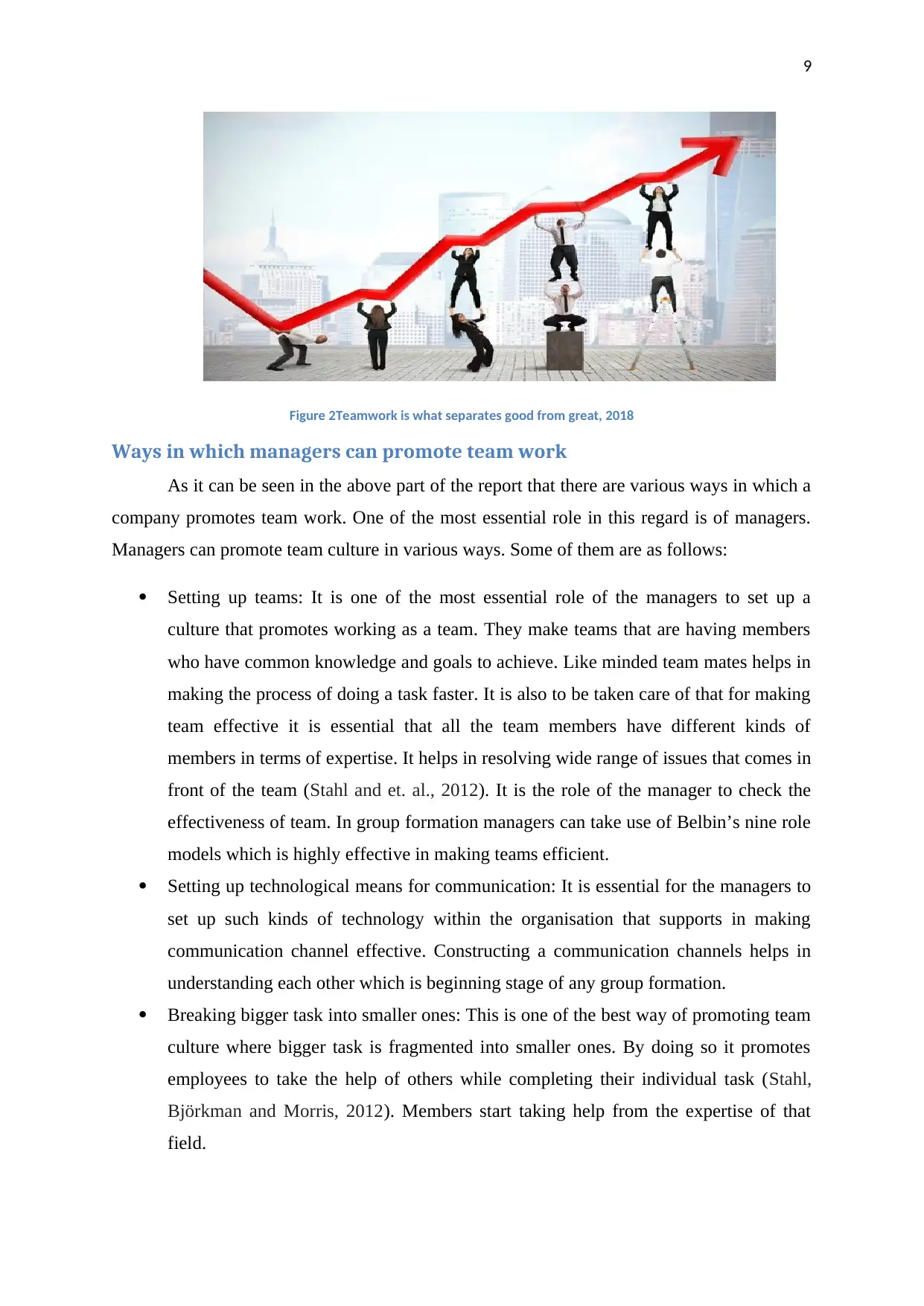
9
Figure 2Teamwork is what separates good from great, 2018
Ways in which managers can promote team work
As it can be seen in the above part of the report that there are various ways in which a
company promotes team work. One of the most essential role in this regard is of managers.
Managers can promote team culture in various ways. Some of them are as follows:
Setting up teams: It is one of the most essential role of the managers to set up a
culture that promotes working as a team. They make teams that are having members
who have common knowledge and goals to achieve. Like minded team mates helps in
making the process of doing a task faster. It is also to be taken care of that for making
team effective it is essential that all the team members have different kinds of
members in terms of expertise. It helps in resolving wide range of issues that comes in
front of the team (Stahl and et. al., 2012). It is the role of the manager to check the
effectiveness of team. In group formation managers can take use of Belbin’s nine role
models which is highly effective in making teams efficient.
Setting up technological means for communication: It is essential for the managers to
set up such kinds of technology within the organisation that supports in making
communication channel effective. Constructing a communication channels helps in
understanding each other which is beginning stage of any group formation.
Breaking bigger task into smaller ones: This is one of the best way of promoting team
culture where bigger task is fragmented into smaller ones. By doing so it promotes
employees to take the help of others while completing their individual task (Stahl,
Björkman and Morris, 2012). Members start taking help from the expertise of that
field.
Figure 2Teamwork is what separates good from great, 2018
Ways in which managers can promote team work
As it can be seen in the above part of the report that there are various ways in which a
company promotes team work. One of the most essential role in this regard is of managers.
Managers can promote team culture in various ways. Some of them are as follows:
Setting up teams: It is one of the most essential role of the managers to set up a
culture that promotes working as a team. They make teams that are having members
who have common knowledge and goals to achieve. Like minded team mates helps in
making the process of doing a task faster. It is also to be taken care of that for making
team effective it is essential that all the team members have different kinds of
members in terms of expertise. It helps in resolving wide range of issues that comes in
front of the team (Stahl and et. al., 2012). It is the role of the manager to check the
effectiveness of team. In group formation managers can take use of Belbin’s nine role
models which is highly effective in making teams efficient.
Setting up technological means for communication: It is essential for the managers to
set up such kinds of technology within the organisation that supports in making
communication channel effective. Constructing a communication channels helps in
understanding each other which is beginning stage of any group formation.
Breaking bigger task into smaller ones: This is one of the best way of promoting team
culture where bigger task is fragmented into smaller ones. By doing so it promotes
employees to take the help of others while completing their individual task (Stahl,
Björkman and Morris, 2012). Members start taking help from the expertise of that
field.
Paraphrase This Document
Need a fresh take? Get an instant paraphrase of this document with our AI Paraphraser
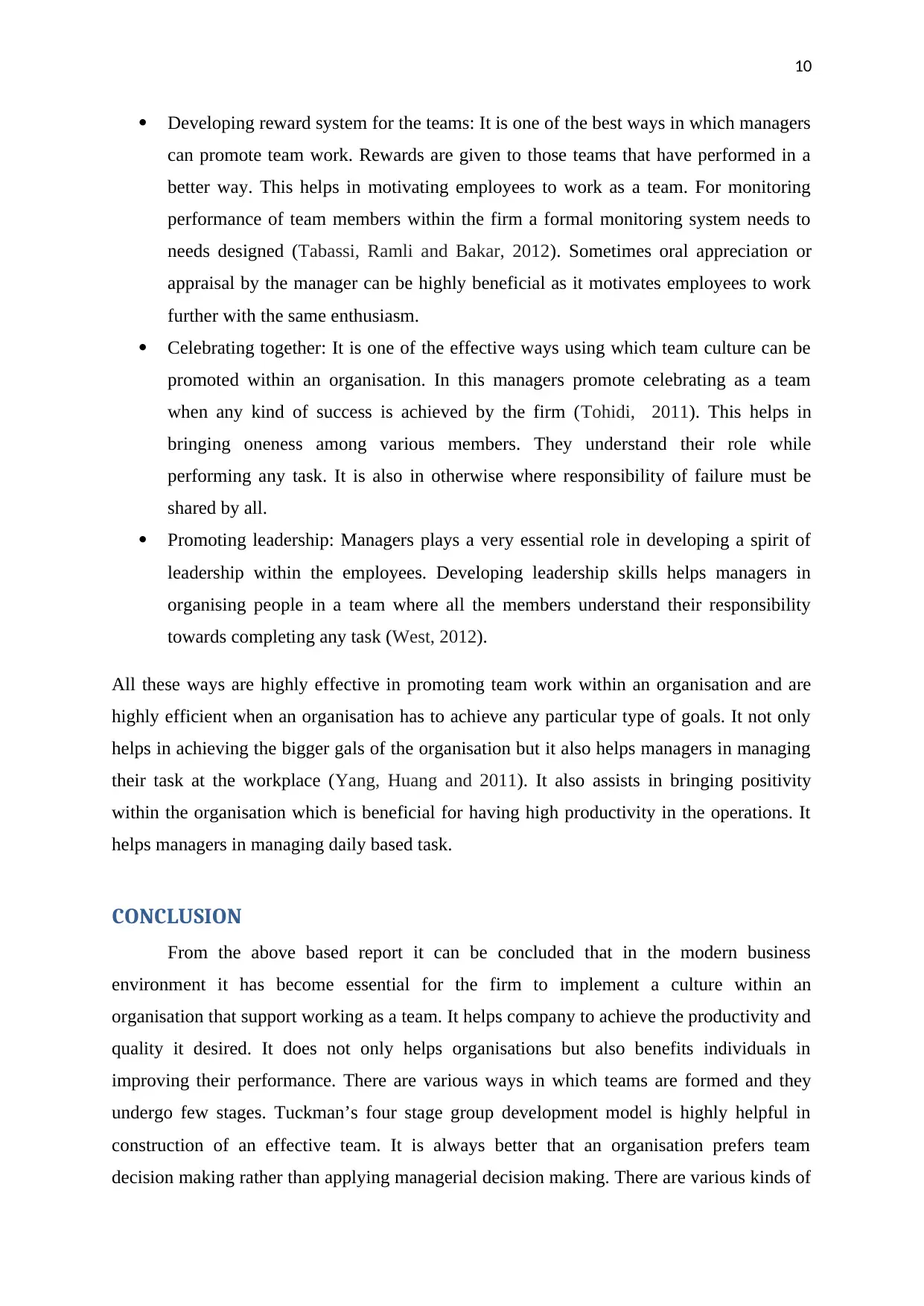
10
Developing reward system for the teams: It is one of the best ways in which managers
can promote team work. Rewards are given to those teams that have performed in a
better way. This helps in motivating employees to work as a team. For monitoring
performance of team members within the firm a formal monitoring system needs to
needs designed (Tabassi, Ramli and Bakar, 2012). Sometimes oral appreciation or
appraisal by the manager can be highly beneficial as it motivates employees to work
further with the same enthusiasm.
Celebrating together: It is one of the effective ways using which team culture can be
promoted within an organisation. In this managers promote celebrating as a team
when any kind of success is achieved by the firm (Tohidi, 2011). This helps in
bringing oneness among various members. They understand their role while
performing any task. It is also in otherwise where responsibility of failure must be
shared by all.
Promoting leadership: Managers plays a very essential role in developing a spirit of
leadership within the employees. Developing leadership skills helps managers in
organising people in a team where all the members understand their responsibility
towards completing any task (West, 2012).
All these ways are highly effective in promoting team work within an organisation and are
highly efficient when an organisation has to achieve any particular type of goals. It not only
helps in achieving the bigger gals of the organisation but it also helps managers in managing
their task at the workplace (Yang, Huang and 2011). It also assists in bringing positivity
within the organisation which is beneficial for having high productivity in the operations. It
helps managers in managing daily based task.
CONCLUSION
From the above based report it can be concluded that in the modern business
environment it has become essential for the firm to implement a culture within an
organisation that support working as a team. It helps company to achieve the productivity and
quality it desired. It does not only helps organisations but also benefits individuals in
improving their performance. There are various ways in which teams are formed and they
undergo few stages. Tuckman’s four stage group development model is highly helpful in
construction of an effective team. It is always better that an organisation prefers team
decision making rather than applying managerial decision making. There are various kinds of
Developing reward system for the teams: It is one of the best ways in which managers
can promote team work. Rewards are given to those teams that have performed in a
better way. This helps in motivating employees to work as a team. For monitoring
performance of team members within the firm a formal monitoring system needs to
needs designed (Tabassi, Ramli and Bakar, 2012). Sometimes oral appreciation or
appraisal by the manager can be highly beneficial as it motivates employees to work
further with the same enthusiasm.
Celebrating together: It is one of the effective ways using which team culture can be
promoted within an organisation. In this managers promote celebrating as a team
when any kind of success is achieved by the firm (Tohidi, 2011). This helps in
bringing oneness among various members. They understand their role while
performing any task. It is also in otherwise where responsibility of failure must be
shared by all.
Promoting leadership: Managers plays a very essential role in developing a spirit of
leadership within the employees. Developing leadership skills helps managers in
organising people in a team where all the members understand their responsibility
towards completing any task (West, 2012).
All these ways are highly effective in promoting team work within an organisation and are
highly efficient when an organisation has to achieve any particular type of goals. It not only
helps in achieving the bigger gals of the organisation but it also helps managers in managing
their task at the workplace (Yang, Huang and 2011). It also assists in bringing positivity
within the organisation which is beneficial for having high productivity in the operations. It
helps managers in managing daily based task.
CONCLUSION
From the above based report it can be concluded that in the modern business
environment it has become essential for the firm to implement a culture within an
organisation that support working as a team. It helps company to achieve the productivity and
quality it desired. It does not only helps organisations but also benefits individuals in
improving their performance. There are various ways in which teams are formed and they
undergo few stages. Tuckman’s four stage group development model is highly helpful in
construction of an effective team. It is always better that an organisation prefers team
decision making rather than applying managerial decision making. There are various kinds of
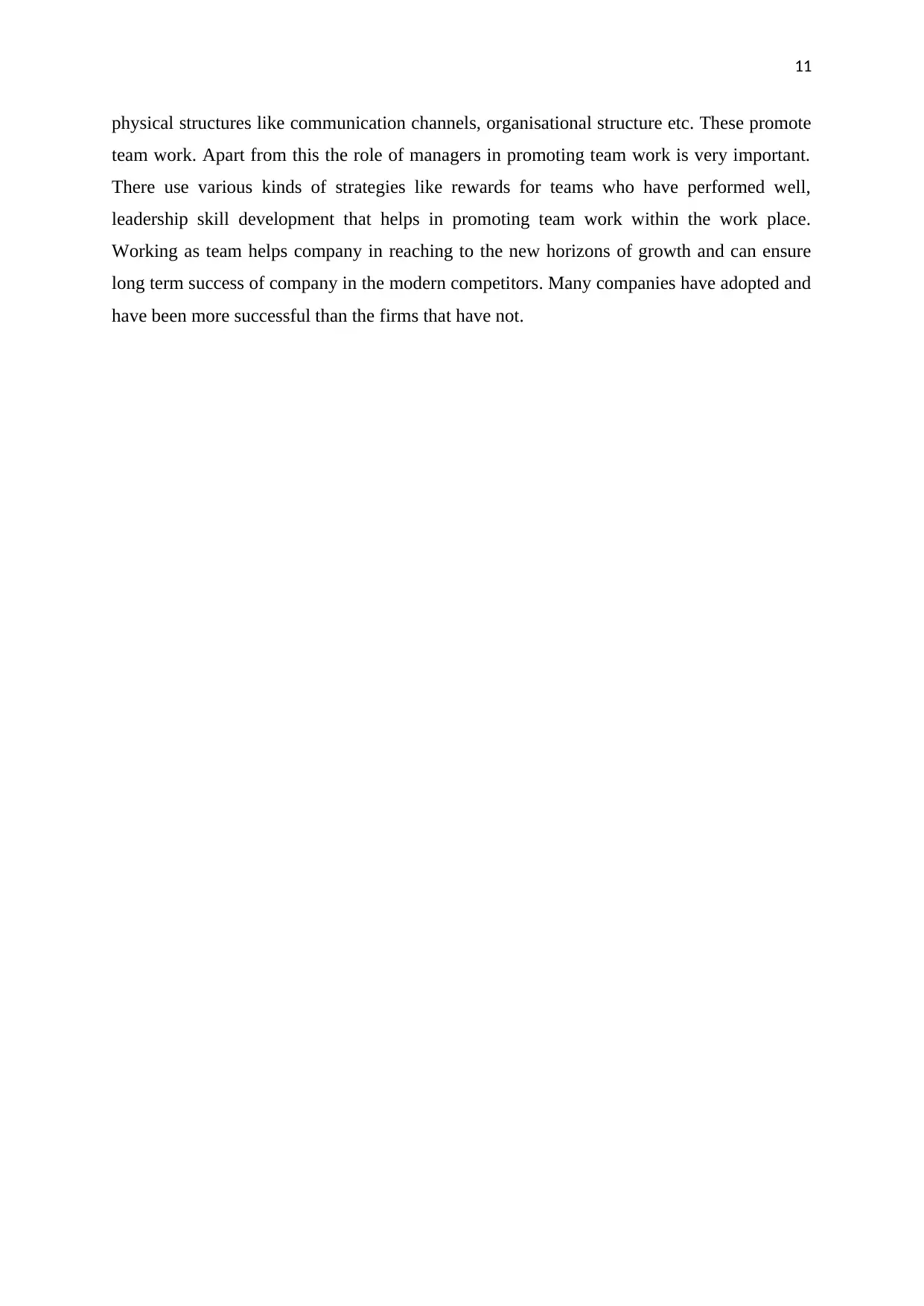
11
physical structures like communication channels, organisational structure etc. These promote
team work. Apart from this the role of managers in promoting team work is very important.
There use various kinds of strategies like rewards for teams who have performed well,
leadership skill development that helps in promoting team work within the work place.
Working as team helps company in reaching to the new horizons of growth and can ensure
long term success of company in the modern competitors. Many companies have adopted and
have been more successful than the firms that have not.
physical structures like communication channels, organisational structure etc. These promote
team work. Apart from this the role of managers in promoting team work is very important.
There use various kinds of strategies like rewards for teams who have performed well,
leadership skill development that helps in promoting team work within the work place.
Working as team helps company in reaching to the new horizons of growth and can ensure
long term success of company in the modern competitors. Many companies have adopted and
have been more successful than the firms that have not.
⊘ This is a preview!⊘
Do you want full access?
Subscribe today to unlock all pages.

Trusted by 1+ million students worldwide
1 out of 15
Related Documents
Your All-in-One AI-Powered Toolkit for Academic Success.
+13062052269
info@desklib.com
Available 24*7 on WhatsApp / Email
![[object Object]](/_next/static/media/star-bottom.7253800d.svg)
Unlock your academic potential
Copyright © 2020–2025 A2Z Services. All Rights Reserved. Developed and managed by ZUCOL.





